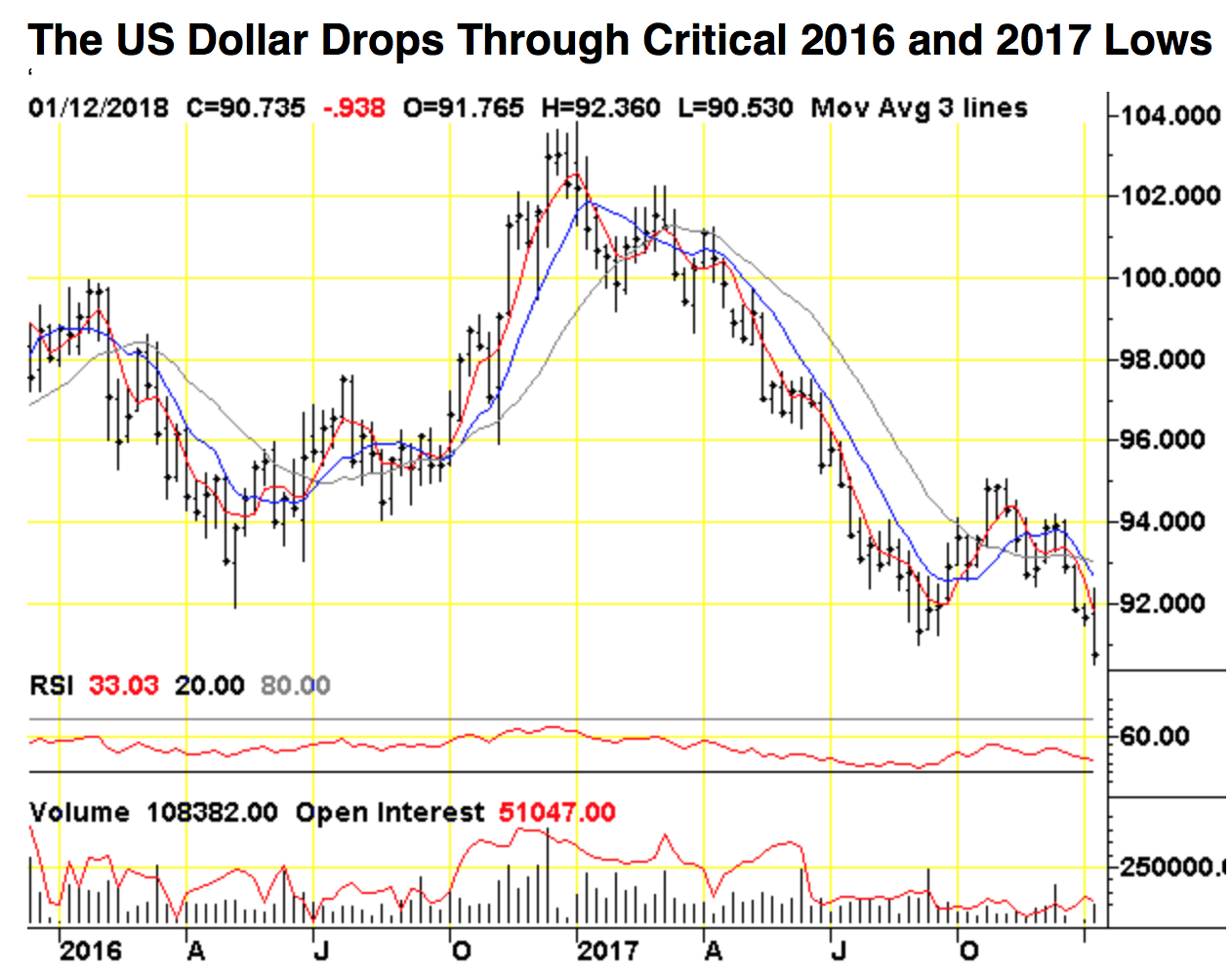Currency
Victor Adair on the US dollar Index breaking down sharply lower below the 2016 & 2017 lows in first few weeks of 2018 while stocks, crude oil, interest rates & Gold move sharply higher



The 91.57 downside target we were using for the dollar looked promising as a place for a powerful bounce to occur. Instead, sellers crushed it on Friday, putting in play a significantly lower target at 88.29 that I would rate as almost certain to be reached.
If so, it would add 2.9% to the Dollar Index’s so far 12.4% decline from the 103.82 high recorded a year ago. It would also undoubtedly quicken the inflation drumbeat we’ve been hearing recently from the usual, benighted sources — i.e., the news media, professional economists and talking heads. I expect my new target, a clear and compelling Hidden Pivot support, to resist sellers for a while, at least. But if it gives way relatively quickly — and by that I mean within a day or two of first being touched — I would infer that the U.S. dollar is headed significantly lower. At the same time, we could expect to see the continuation of some big trends, including lower prices for Treasury bond and notes, and higher prices for stocks, crude oil, precious metals and of course bitcoin.
click here for a two-week free trial to Rick’s Picks

With US markets closed for holiday, it has been a quiet, low-liquidity European session, with Asia similarly subdued, while continued USD weakness, now in its 4th consecutive day, has been the main focus as Bloomberg’s dollar index approached its lowest level in three years, helping push the euro up to its strongest since 2014.
Indeed, in lieu of active equity markets, it’s been all about FX and the tumbling dollar and overnight the EURUSD rose to a new three year high just shy of 1.23 before easing off, while cable briefly rose above 1.38 – its highest level since Brexit – and the Mexican Peso was well supported by an unconfirmed Axios reports that was Trump softening his stance on Nafta, at least until Reuters denies it.

The Euro was boosted by growing expectations of tighter monetary policy from ECB, while the chance of a pro-European Union coalition in Germany also boosted confidence in the continent.
“The latest leg up in the euro has clearly come from optimism that the German government is moving towards an agreement for a coalition government,” said Investec economist Victoria Clarke.

 After hitting $20,000 in mid-December, bitcoin prices keep drifting lower.
After hitting $20,000 in mid-December, bitcoin prices keep drifting lower.
Looking at the news, it’s clear to me why this is happening.
On Monday, the Financial Industry Regulatory Authority (FINRA), the organization that regulates brokers, advisers and financial institutions in the United States, announced that it was going to focus on cryptocurrencies.
FINRA is a big deal if you manage money or if you are a financial adviser … you have to follow its rules and subject yourself to its examinations.
Merrill Lynch, one of the biggest financial broker and advisory companies in the U.S., banned any cryptocurrency investments in its accounts.
The Chinese government this week announced a plan for an orderly end to bitcoin mining.
That’s right after Visa Europe canceled cards that allowed users to access bitcoin.
This comes right after the South Korean government started requiring real names for all cryptocurrency transactions. The government also banned banks from opening accounts for virtual currencies.
The Indian government is waging war on bitcoin and cryptocurrencies by choking the flow of cash to anyone who’s trading these assets.
If you’ve been in markets long enough, you can see a familiar pattern here…
Putting the Squeeze on Cryptocurrency Investments
This rapid-fire set of announcements looks to me like a coordinated squeeze on cryptocurrency investments. And it reminds me of a similar squeeze that I personally experienced before where I lost money.
PartyGaming. Sportingbet. PokerStars. 888 Holdings. You’ve never heard of these companies, even though they were once highfliers in online gambling through poker.
The thing is, online gambling is illegal in the United States. And most of their customers were U.S. citizens.
These companies skirted around U.S. law by operating their websites from places like Costa Rica, the Caribbean and the United Kingdom. For a while, the U.S. government tolerated this activity.
Then, on October 2, 2006, the government lowered the hammer.
It secretly added rules into a transportation law called the SAFE Port Act. These rules made it illegal for American banks and credit card companies to process payments to online gaming companies.
By doing this the government chopped off the lifeblood of these businesses — money flow.
You see, everyone gambling online used credit cards or bank transfers to fund their betting. If you made it illegal to process transfers to online gambling companies, you starved these companies of their source of cash.
Overnight, 90% of their sales disappeared. Instantly their stocks crashed. They never recovered.
A Big Threat to Government Power
So here’s why this matters to bitcoin and cryptocurrencies.
I believe that governments are looking to crack down on bitcoin and cryptocurrencies because they see them as a threat to their monopoly power to issue currency.
Governments around the world derive great power from their ability to issue their national currency. It’s completely against their interests to have a new currency compete with their monopoly in issuing currency.
The fact that people are using bitcoin and cryptocurrencies to transfer wealth, avoid taxes and for illegal activities is also a big threat to government power.
If everyone shifted to bitcoin or cryptocurrencies, then the government’s tax collection would go to zero. And it could lose its ability to enforce law and control the economy.
The bottom line: Bitcoin and cryptocurrencies represent a threat to a government’s power.
Cutting off the Money Flow
The U.S. China. South Korea. Europe. India. These are substantial markets for bitcoin and cryptocurrencies.
These governments know banning bitcoin and cryptocurrencies can cause social and political unrest. Instead, they are going to squeeze them dry using the same technique they used to get the online gaming companies: They are going to starve the cryptocurrency exchanges of money flow.
Cutting off the money flow from new clients and cash will slowly dry up the trading and liquidity in bitcoin and cryptocurrencies. The government will keep squeezing until these markets are no longer a threat to them.
Now, those who own bitcoin and other cryptocurrency investments are going to dismiss this threat. They believe that bitcoin and cryptocurrencies are going to stay strong even as governments put the squeeze on these assets.
I believe they are wrong. And my experience with online gambling stocks is just one example of how harshly governments will act when their powers are threatened.
Regards,

Paul Mampilly
Editor, Profits Unlimited



As I scan the papers, and the web, I have noticed bank analysts and newsletter writers are becoming increasingly bearish on the US dollar. Effectively, the dollar downtrend will continue in 2018 is the view. This seems the consensus thinking to justify a dollar bearish view:
• All good news is already priced in the US dollar, for instance:
-
Three rate hikes by the Fed in 2018
-
Tax cut legislation will have only a minimal flow-through beneficial on the US economy in
2018.
• Given the synchronized global recovery, other central banks will start to play catch-up on interest rates and that will be bad for the dollar.
It makes sense. But lots of things make sense in the investing world until Mr. Market decides to prove rationales flawed.
If we use net bullish positioning in the Euro-USD CME futures contracts as a proxy for dollar bearishness, you can see we may be near some type of extreme:

At +113.9k net bullish Euro-USD positioning, it represents the highest on record going back to the beginning of 2009. Hmmm…this represents lots of potential selling pressure should dollar bearish rationales prove wrong; let’s take a look at what might do just that.
As it relates to the tax cut; the more one looks at that animal the better it appears. But the mainstream media would never give Trump credit for anything good. So, for the most part, the public is exposed to sniping and cherry-picking on the tax cut from the mainstream media. But there is lots of good in there, granted it’s not perfect. It is always odd to me when others complain about keeping more of their own money.
“I am in favor of cutting taxes under any circumstances and for any excuse, for any reason, whenever it’s possible.
The reason I am is because I believe the big problem is not taxes, the big problem is spending.
The question is, ‘How do you hold down government spending?’ Government spending now amounts to close to 40% of national income not counting indirect spending through regulation and the like.
If you include that, you get up to roughly half. The real danger we face is that number will creep up and up and up.
The only effective way I think to hold it down, is to hold down the amount of income the government has. The way to do that is to cut taxes.”
–Milton Friedman
From The Wall Street Journal today:
Besides tax reform, one of President Donald Trump’s most cherished goals is reducing the gaping U.S. trade deficit.
In a little-appreciated way, the tax bill expected to pass Congress this week may do just that. This wouldn’t come by making businesses and workers more productive or changing other countries’ trade practices, but by curbing the incentive for multinational companies to artificially shift profits abroad.
Independent research suggests this could reduce the trade deficit by half, or roughly $250 billion a year, and deliver a one-shot 1% or greater boost to annual gross domestic product. This would be an accounting effect rather than a change in actual business or worker income. (It would also be independent of any increased work or investment from lower tax rates.) Nonetheless, some analysts think the positive optics might curb some of Mr. Trump’s protectionist instincts, which are heavily driven by the trade deficit.
Analysts at Deutsche Bank are even more optimistic. They estimate the deficit could be reduced by $150 billion to $270 billion a year, with a corresponding one-off boost to GDP of as much as 1.4%. They think this effect could materialize in as little as year, judging by a similar tax change in Britain in 2009.
Hmm…a one-off potential jump in GDP of 1.4% and shrinking trade deficit. Sounds good, and may mean those expecting only three hikes and moderate-benefit from tax reform may want to get their forecast erasers ready.
The chart below shows the US Current Account (current in deficit of -112.82 billion) versus the US Dollar Index since 2000. The current account deficit started improving in mid-2006 (just before the credit crunch and likely a contributing factor—see Triffin dilemma) and the US dollar has followed. So, if the current account improves further as the WSJ and others suggest, does it make sense to be dollar bearish, at least longer term?

And of course, there is more in the President’s bag of tricks. This excellent summary, “Trump offers a daring program to restore US dominance,” from David P. Godman, writing in the Asia Times, of the latest US national security report in which President Trump spoke briefly about yesterday. Some excerpts [my emphasis]:
• According to a preliminary copy of the president’s 2017 National Security Strategy obtained by the Asia Times, Trump envisions a radical upgrade in the US industrial base, large- scale support for scientific and technical education, and rebuilding of infrastructure, in response to China’s economic and strategic challenge. [Thinking that might be growth positive.]
-
The contrast with the two previous administrations is stark. The Trump report praises American values and institutions but betrays no ambition to remake the world in America’s image after the fashion of George W. Bush. Nor does it accept the slow decline of American influence into a geopolitical mush of multilateralism per the “soft power” conceit of the Obama Administration. It is centered on the American economy, the American homeland, and American interests, but it proposes a rough-edged activism where American interests are threatened that will make the world a less predictable place during the next several years. [Hoping this isn’t a green-light for neo-cons of course.]
-
The report embraces the term “America First,” by which Trump means that national security depends first of all on fixing what is wrong in America: a shrinking industrial base, disrepair in infrastructure, sagging innovation, inadequate scientific and technical education, and an excessive federal debt burden. [Bingo! Work on the problems here first before we tell others what they should be doing. This is exactly why we “deplorables” voted for him.]
-
Early press coverage already has misrepresented the report as a trade-war screed. It is nothing of the sort: on the contrary, it repudiates the complacency of the past several administrations who presided over a gradual deterioration of America’s competitive and strategic position. [Bingo! Tilt!]
- The Trump strategy does not blame America’s competitors for its economic problems, let alone propose a trade war. The term “tariff” does not appear at all in the draft copy reviewed by this publication; ostensible currency manipulation is nowhere mentioned; and the term “dumping” appears only once. Instead, the report takes aim at the industrial policy of Asian nations who “subsidized their industries, forced technology transfers, and distorted markets. These and other actions challenged America’s economic security.” But the next sentence makes clear that America’s injuries for the most part were self-inflicted: “At home, excessive regulations and high taxes stifled growth and weakened free enterprise – history’s greatest antidote to poverty. Each time government encroached on the productive activities of private commerce, it threatened not only our prosperity but also the spirit of creation and innovation that has been key to our national greatness.” [Mana from heaven.]
I have linked the full article above. Lots of interesting stuff in there and well worth the read.
The point in sharing this is to suggest just maybe the US will grow a lot faster than expected in 2018. The framework is there for a self-feeding virtuous flow of money into America.
Granted, words on a paper and implementation are two different things; especially in a world where US politicians have so many conflicting interests they put ahead of the general welfare of the country. But, stranger things have happened.
So, if you are a long-term US dollar bear, you may want to be a cautious one.
Jack Crooks, President,
Black Swan Capital
772-349-6883/ Twitter: bswancap












